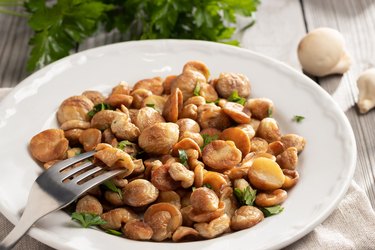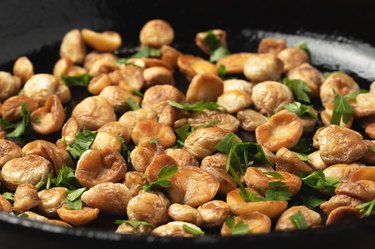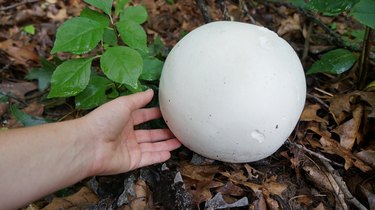
Puffball mushrooms can range from golfball-sized to the size of a watermelon. They're not commonly found in the grocery store, but if you've stumbled upon them growing out in the wild, learning how to cook puffball mushrooms is your next step.
Giant puffball mushrooms aren't just fascinating to look at — they taste great sautéed or fried. Below, we share some chef-approved puffball mushroom recipes you can try if you're lucky enough to come across this extraordinary fungi.
Video of the Day
Video of the Day
Can You Eat Puffball Mushrooms?
Brown puffball mushrooms aren't edible, but you can eat puffball mushrooms when they're milky white.
Edible puffball mushrooms have pure white flesh similar to marshmallows or fresh mozzarella, per the U.S. National Park Service.
To tell if a puffball mushroom is safe to eat, inspect the outside and slice it open. Both the inside and outside should be white and firm with no yellow or mushy parts, per the Wisconsin Department of Natural Resources. If it's brown or has any blemishes, it may not be edible and you should throw it out.
What Are Puffball Mushrooms?
Puffball mushrooms are a type of fungi that can produce up to seven trillion spores. When they mature, clouds of spores (or "puffs") explode out of the mushroom when they're disturbed. Then, the wind carries these spores, which travel and land on the ground to eventually create new puffball mushrooms.
You want to look for puffballs that are smooth and white, with a soft, bread-like texture inside. If there are any blemishes on the puffball, it may be poisonous and should not be eaten. Talk to a mushroom expert before eating any mushrooms you've picked.
Puffball Mushroom Nutrition
In general, mushrooms are a good source of B vitamins, vitamin D and selenium, according to Colorado State University.
How to Cook Puffball Mushrooms
Puffball mushrooms aren't really popular for their flavor — they're often likened to tofu because they have a similar texture and can take on the flavor of other ingredients in a recipe.
"Puffball mushrooms are so much fun to find and cook," says celebrity chef Serena Poon. "My favorite way to cook these delightful fungi is to sauté them with leafy greens in an Asian-inspired sauce and eat on top of a bowl full of cooked ancient grains."
Here, Poon shares how to cook puffball mushrooms with a delicious sauce.
Sautéed Puffball Mushroom Recipe

In Poon's simple puffball mushroom recipe, you'll sauté or lightly fry them in avocado oil, which is great for cooking with high heat. Toasted sesame oil adds a slightly nutty flavor and pairs well with tamari, ginger and Himalayan pink salt for an Asian-inspired sauce you'll love.
Things You'll Need
Sauté pan or wok
Puffball mushrooms
Avocado oil
Toasted sesame oil
Chopped garlic
Chopped ginger
Tamari
Himalayan pink salt
Cutting board
Knife
Paper towel or dish towel
Leafy greens like bok choy or napa cabbage
- Rinse your puffball mushrooms under running water, but don't let them soak in the water (this can add too much moisture, which can affect the texture). After rinsing, dry them with a paper towel or dish towel and place them on a cutting board.
- Slice the puffball mushrooms into cubes with a sharp knife. Puffball mushrooms can range in size, so try to cut them in similar sizes so they cook evenly.
- Heat your sauté pan or wok over medium-high heat and add the oils when the pan is hot.
- Once the oil is hot, add the chopped garlic and ginger. Then, add your tamari and Himalayan pink salt and cook until the mixture has browned.
- Add your cubed puffball mushrooms to the hot pan with the sauce. Once the mushrooms begin to brown, add a large handful of leafy greens, such as bok choy or napa cabbage.
- Sauté for a few more minutes until the leafy greens have cooked down and the mushrooms are browned. Depending on the size of the puffball mushroom cubes, it should only takes a few minutes for them to brown over medium-high heat.
- Once the mixture is finished cooking, remove from heat and serve immediately over a bed of cooked grains, such as white or brown rice or farro.
How Long Should You Cook Puffball Mushrooms?
How long you should cook puffball mushrooms will depend on their size when you're cooking them. If you're chopping them into small cubes for sautéing, they will only take a few minutes to brown over medium-high heat.
If you're slicing puffballs into large, thick slices for frying, they may take longer to cook. You'll know they're done when the batter turns golden brown.
How to Fry Puffball Mushrooms
Puffball mushrooms are naturally mild in flavor, so they are very versatile. You can use them like you would other varieties of mushrooms.
"There are so many ways to cook puffballs — grilling, drying, smoking and frying," says chef Sean Sherman. One of Sherman's favorite ways to cook them is simply frying large slices.
"I really enjoy dusting the sliced puffballs in cornmeal or wild rice meal, seasoning them with a bit of salt, then gently frying them in sunflower oil," he says. "From there, fried puffball mushrooms can be eaten as an appetizer with a variety of dipping sauces. They're also great scattered on a salad or tossed with sautéed onions and chilies."
Other Ways to Eat Puffball Mushrooms
Other ways to eat puffball mushrooms include:
- Incorporating them into pizza
- Grilling them like a portobello burger
- Topping salad with them
- Smoking them for flavor
- Adding them to soup
- Sautéing and using them on top of toast
- Dehydrating and freezing for later
- Browning them in butter
Tip
You do not need to peel puffball mushrooms.
How to Identify a Puffball Mushroom

Puffball mushrooms are common in the U.S. and Canada. They emerge in late summer and fall in meadows, stands of trees and around forest openings, according to Iowa State University.
You can also sometimes find them on lawns during particularly wet stretches. You might even see them on sports fields or highway medians.
They grow in the ground from spreading underground roots. They can grow quite large, and the giant puffballs are the easiest to spot.
Here's how to identify a puffball that's safe to eat:
- Look for a smooth white mushroom that's round to oblong.
- Make sure it can easily be picked off the ground.
- The inside should also be a solid white, with no blemishes on the flesh. Any blemishes or discoloration inside or out indicate the puffball is poisonous.
If you're unsure about whether the puffball is safe to eat, consult your local authorities or just don't eat it to play it safe.
Warning
There are mushrooms similar to young puffballs, called Amanita mushrooms, that have gills inside their flesh, but these are not puffballs — and they're not edible.
Mistaking puffballs for Amanita mushrooms can be deadly, according to the Missouri Department of Conservation. Puffballs often look like large white volleyballs sitting on the ground, although they may not be perfectly round.
Picking and Storing Puffball Mushrooms
Puffballs live underground until the right conditions cause them to burst forth from the ground in late summer and fall, according to Utah State University.
Giant puffballs can grow quickly. The largest can be almost 2 feet long, according to Utah State. They are usually round or pear-shaped.
If you plan to eat a puffball, you must pick it when it's just right. Puffballs safe for eating are smooth and have the color of a creamy, solid white on both the outside and inside. Once the inside turns mushy or is yellow, brown, black or purple, it is not edible, per Utah State. (A puffball is edible for a short time.)
Puffball mushroom storage isn't easy — these fungi don't store well, and that's one reason why you don't often see them for sale commercially. They last a few days and can be stored in the refrigerator. But if something seems off, or they begin to darken, you shouldn't take a chance. It's best to eat a puffball soon after it's been picked.
Poison Mushroom Guide
Even safe wild mushrooms can have negative health effects on sensitive people. (Foraging for mushrooms is worlds different from eating canned mushrooms.) Follow this protocol to avoid mushroom poisoning, according to Michigan State University:
Never eat any mushroom unless you have positively identified the species.
Cook all mushrooms thoroughly and never eat a wild mushroom raw.
Be careful the first time you eat a new mushroom —
only eat a small amount rather than too many mushrooms. Then wait several hours to make sure there is no reaction. Some mushroom species react with alcohol, so be sure you know which ones do, and avoid alcohol (for two to three days) if you eat those species.
Save a small portion of any new mushroom you eat, as it will be helpful to medical staff in the event it makes someone sick.
Never try mushrooms that are not considered generally safe to eat. For more information on how to identify edible mushrooms, visit Midwest American Mycological Instruction or a County Extension Office in your state to get information specific to where you live.
- Michigan State University: "Identifying Wild Michigan Mushrooms That Are Safe to Eat"
- Colorado State University: "Mushrooms"
- U.S. National Park Service: "Species Spotlight - Puffballs"
- University of Rochester: "Mushroom Barley Soup"
- Missouri Department of Conservation: "Giant Puffball"
- Wisconsin Department of Natural Resources: "Foraging for Football-sized Fungi"
- Iowa State University: "Puffball"
- Utah State University: "Giant Puffballs"